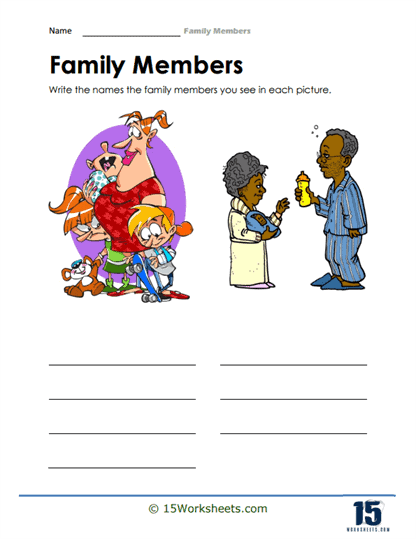

This series of 15 worksheets is designed to help students learn and understand the vocabulary related to family members. The exercises in these worksheets aim to teach students the names of different family members and how they are related to one another.
Some exercises in the worksheets include identifying family member names by using pictures as visual clues, which can help students learn to associate the names of family members with their images. Other exercises involve determining the family member based on their relationship with other family members, such as identifying who is the father or sister of a given family member.
Students are also asked to talk about their own family members and share information about them, such as their names, ages, and relationships to one another. This can help students develop their speaking and listening skills, as well as their vocabulary and cultural knowledge.
Additional exercises also include tracing family member names, drawing pictures of family members, and writing a paragraph about their own families while using family member names correctly. These activities can help students develop their fine motor skills, as well as their ability to recognize and spell different family member names.
Learning about family members is an important part of language development and cultural understanding. By learning about different family members and how they are related to one another, students can develop their vocabulary and understanding of relationships, as well as gain a deeper appreciation for the importance of family in different cultures.
Overall, these worksheets provide an excellent resource for teachers and homeschooling parents who are looking to help their students improve their language skills and develop a deeper understanding of the importance of family.
In the English language, specific names are given to each family member. These names are based on the family member’s gender and relation to a specific person.
Family members, also known as relatives, are divided into immediate (or nuclear) and extended (or distance). In the following examples, family members are named based on their relation to person A.
Naming Immediate Family Members
Person A’s immediate family consists of a father (male) and mother (female), who are A’s birth parents. If either of these individuals is not A’s birth parents, they become the adopted father and adopted mother, respectively. Any other offspring that A’s parents have are A’s siblings called a brother (male) and sister (female).
Suppose A’s parents get divorced and remarry other people. In that case, these new additions are stepparents. The father’s new wife is A’s stepmother, while the mother’s new husband is A’s stepfather. Any subsequent offspring will be A’s half-sibling, specifically half-brother (male) and half-sister (sister).
A’s spouse would either be a husband (male) or wife (female), with their resulting children being sons (male) or daughters (female). Suppose A’s spouse has children from a previous relationship. These children become A’s stepchildren, named stepson (male) and stepdaughter (female).
Naming In-Laws
Suppose B is the spouse of A. Since marriage is a union bound by law, every member of B’s family is now that relative-in-law to A. Therefore, B’s father and mother are A’s father-in-law and mother-in-law. B’s siblings are A’s brother-in-law and sister-in-law. B’s grandparents are A’s grandfather-in-law and grandmother-in-law.
Naming Extended Family Members
Each of A’s parents has their own set of parents. They are A’s grandparents, known as grandfather (male) and grandmother (female). Note that there is no distinction between grandparents on the father’s or mother’s side. Person A has two sets of grandparents.
If either of A’s grandparents has siblings, they become A’s great-uncle (male) and great-aunt (female).
Each grandparent has its own set of parents. These relatives are A’s great-grandparents. They are called great-grandfathers (male) and great-grandmothers (female). Person A has four sets of great-grandparents.
If either of A’s siblings gets married, then their spouses would be either A’s brother-in-law (male) or sister-in-law (female). Any children from these marriages become A’s nephews (male) and nieces (female).
If A’s children marry, their spouse becomes A’s son-in-law (male) and daughter-in-law (female). Any children from these unions become A’s grandsons (male) and granddaughters (female). These children are also great-grandchildren to A’s grandparents. And great-great-grandchildren to A’s great-grandparents.
If either of A’s parents has siblings of their own, they become A’s uncles (male) and aunts (female). The people who marry A’s uncle or aunt have no blood relation to A and therefore are known as uncle by marriage and aunt by marriage. Any children, male or female, that A’s uncle or aunt has with their spouses are A’s first cousins.
If any of A’s cousins get married, these individuals do not have any blood relation with A and are known as the cousin’s husband (male) or wife (female). However, any children from these marriages are A’s cousins once removed.
A Note On Cousins
The degree of cousins depends on which generation of grandparents they have in common. For example, a first cousin shares a common grandparent; a second cousin will share a common great-grandparent. The third cousin shares a common great-great-grandparent, and so on.
When any degree of a cousin has a child, that child becomes the same degree once removed. For example, the child of a first cousin is the first cousin once removed, while the child of a third cousin is a third cousin once removed.